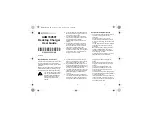
5
headline bars
tabs
con
tinua
tion tabs
not
es
w
ar
nings
headline bars
tabs
continuation tabs
notes
warnings
lead-acid batteries only. It is not intended
to supply power to a low voltage electrical
system other than in a motor-starting
application.
•
NEVER
charge a frozen battery.
•
NEVER
overcharge a battery.
• Consider having someone nearby to come
to your aid when you work near a lead acid
battery.
• Battery acid is a highly-corrosive sulfuric
acid. Have plenty of fresh water and soap
nearby in case battery acid comes into
contact with your skin, clothing or eyes.
• Wear complete eye and body protection,
including safety goggles and protective
clothing. Avoid touching your eyes while
working near the battery.
• If battery acid comes into contact with your
skin or clothing, immediately wash the area
with soap and water. If acid enters your eye,
immediately flood the eye with cold running
water for at least 10 minutes and seek
medical attention right away.
• If battery acid is accidentally swallowed,
drink milk, the whites of eggs or water. Do
not induce vomiting. Seek medical attention
immediately.
PREPARING TO CHARGE
•
If it is necessary to remove the battery from
the vehicle to charge it, always remove the
grounded terminal first. Make sure all of the
accessories in the vehicle are off to prevent
arcing.
•
Be sure the area around the battery is well-
ventilated while the battery is being charged.
•
Clean the battery terminals before charging
the battery. During cleaning, keep airborne
corrosion from coming into contact with your
eyes, nose and mouth. Use baking soda and
water to neutralize the battery acid and help
eliminate airborne corrosion.
DO NOT
touch
your eyes, nose or mouth.
•
Add distilled water to each cell until the
battery acid reaches the level specified by
the battery manufacturer. Do not overfill.
For a battery without removable cell caps,
such as valve-regulated lead-acid batteries
(VRLA), carefully follow the manufacturer’s
recharging instructions.
•
Read, understand and follow all instructions
for the charger, battery, vehicle and
any equipment used near the battery
and charger. Study the entire battery
manufacturer’s specific precautions while
charging, and understand the recommended
rates of charge.
•
Determine the voltage of the battery by
referring to the vehicle’s owner’s manual. If
the charger has an adjustable charge rate,
charge the battery at the lowest rate first.
•
Make sure that the charger cable clips are
tightly connected to the battery posts.
WARNING! EXPLOSION HAZARD
• Working in the vicinity of a lead-acid battery is dangerous. Batteries generate explosive gases during normal
operation. For this reason, it is important that you follow the instructions each time you use the charger.
• To reduce the risk of a battery explosion, follow the instructions and those published by the battery
manufacturer and the manufacturer of any equipment you intend to use in the vicinity of the battery. Review the
cautionary markings on these products and on the engine.
• DO NOT drop a metal tool onto the battery. It could cause a spark or short-circuit the battery or other electrical
part which could cause an explosion.
• DO NOT use this battery charger for charging dry-cell batteries that are commonly used with home appliances.
These batteries may burst and cause injury to persons and damage to property.
headline bars
tabs
con
tinua
tion tabs
not
es
w
ar
nings
SAFETY INFORMA
TION


































